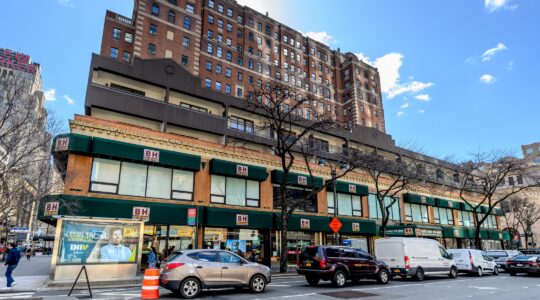A cup of coffee and a Danish.
For the last 20 years, lunchtime for Rabbi T. has meant a two-and-a-half block walk from one Lower East Side institution, Mesivta Tifereth Jerusalem, the yeshiva where he teaches Talmud, to Gertel’s, a kosher bakery where he buys a snack and sits at a small table, reviewing a Hebrew text. (Many members of the haredi community are publicity-shy.)
Starting Monday, Rabbi T. will have to get his lunch somewhere else.
A sign posted in the store’s window this week announced that today is Gertel’s last day of business as a walk-in retail store. The bakery will remain open for the wholesale trade, making deliveries to stores, families and Jewish institutions, until it moves to a yet-to-be-determined location in Williamsburg next month, and maybe opens small retail outlets in the future.
Following by seven years the closing of Ratner’s popular dairy restaurant as a kosher establishment, the departure of Gertel’s appears on the surface to be a sign of a neighborhood in decline. But several prominent Lower East Side residents say that isn’t the case. The area has undergone a renaissance in the last decade, they say, and the selling of the Gertel’s building — the same for Ratner’s — is a sign of the area’s economic viability.
The bakery’s building is being sold, says Heshy Jacob, chairman of the board of the United Jewish Council of the East Side, “because it is too valuable to hold onto. Our neighborhood is gentrifying.”
“The end of the world it isn’t,” Jacob says. “Is it the best sign? No. It isn’t a terrible sign.”
Abe Stern, the owner of Gertel’s for 21 years, says he sold the building to developers who will build a co-op apartment building on the site.
“There wasn’t enough business” to keep the retail store open, he adds. “I used to have a lot of people walking in here.”
On Tuesday at lunchtime the place was empty.
Lower East Side residents say competition from nearby kosher bakeries, and the loss of nearby Orchard Street as a Jewish shopping area, cut Gertel’s walk-in business.
The bakery’s retail trade has declined by 85 percent since he bought the business, Stern says. To compensate, Stern, a member of the Satmar chasidic group whose late father was a baker in Romania before World War II, has expanded Gertel’s wholesale business, which now brings in most of the store’s profits and accounts for the increase in employees from 10 to 25. Stern declines to give exact business figures.
While he is talking in his office, Stern shakes hands with a business colleague, a member of the Chinese-American community, who stops in to wish him well on his impending move.
The only official notice about the bakery’s last day was the sign in the window, Stern says. No Web site, no newspaper ads. “Simply word of mouth.”
“This week we see people” — steady customers — “constantly crying” about the store’s demise, Stern says. “Every day.”
“I heard rumors. It’s depressing,” Rabbi T., the only customer in the store, says over lunch this week, balancing his coffee on a plastic chair, dwarfed by stacks of cardboard boxes that are ready for pre-Shabbat deliveries. “It’s an institution,” he says. “It has an excellent reputation.”
Gertel’s is under supervision of the Brooklyn-based CRC kashrut agency.
When the rabbi, who asked that his name not be used, started his lunchtime ritual, the bakery was packed; customers would take a number and wait to be served. Gertel’s is one of the oldest kosher bakeries in New York. Its scaling down of operations and departure from the Lower East Side, where it has sold its storied rugelach and challahs since 1914 on Hester Street, corner of Essex, means the loss of another landmark Jewish business that defined the character of a once majority-Jewish neighborhood, the first stop for Jewish immigrants a century ago. The 1960s and 1970s witnessed an exodus of thousands of Jews, especially upwardly mobile young families, while other groups of newcomers moved in and leaders of the area’s Jewish organization mounted campaigns to keep the Lower East Side a Jewish area.
“I’m not worried; Jewish life is still here,” says David Weinberger, community coordinator at The United Jewish Council of the East Side. The area’s Jewish population, about 20,000 in 1990 and 30,000 in 2000, is probably larger today, says William Rapfogel, executive director of the Metropolitan Council on Jewish Poverty and a lifelong resident of the Lower East Side. “There’s no question about it.”
“I don’t think [Gertel’s closing] means anything in terms of Jewish life. It doesn’t reflect on the community,” Rapfogel says. “It reflects on the value of the building.”
Property values in the neighborhood have risen dramatically in the last 10-15 years, Rapfogel says. The bakery’s sale, he says, “means that the real estate opportunity for the people who own it was too great to resist.”
“It’s not a sign that the community is dying,” he says, listing the extant kosher restaurants and groceries and pickle stores that serve a Jewish community that, while not as Orthodox as in past years, remains disproportionately observant.
“There are three [kosher] bakeries within three blocks of my house,” Rapfogel says.
Leon Schreiber, a retiree who has lived in the neighborhood since 1932, says the selling of the Gertel’s building is another sign that the Lower East Side is changing. He points to “a treif store” on Orchard Street, formerly the area’s kosher commercial center, where pork products are now sold.
An olive-green Gertel’s cap atop his head, Schreiber says he has steadily patronized the bakery since Ratner’s closed.
Mark Kushner, a mohel who lives in the Philadelphia area, says he always makes a side trip to Gertel’s when performing a circumcision here.
This week — probably the last time he would walk into the bakery — he bought an extra babka for his family for Shabbat. For old time’s sake, he says.
Rabbi T. says he also plans to get some extra snacks for his family when he stops in for lunch today.
After he buys his last coffee and Danish.
The New York Jewish Week brings you the stories behind the headlines, keeping you connected to Jewish life in New York. Help sustain the reporting you trust by donating today.




